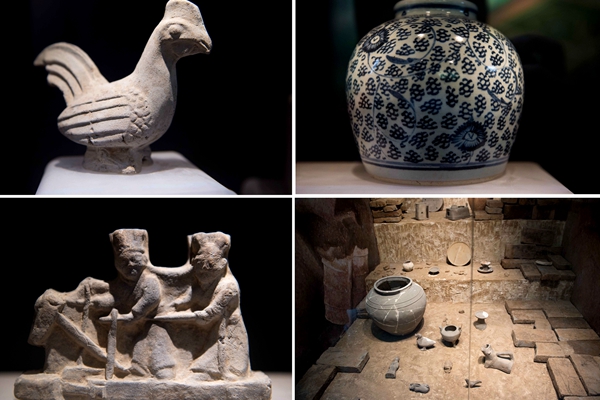
Four of the cultural relics found during the archaeological exploration by nine teams of experienced archaeologists from across China in Tongzhou, from Feb 26 to Sept 28.[Photo/Xinhua]
A 500,000 square meter Han Dynasty (206 BC-AD 220) archaeological site has been uncovered in Tongzhou, Beijing’s new subcenter.
Yu Ping, spokesperson for the Beijing Municipal Administration of Cultural Heritage, said the discovery had revealed much about the area’s history over the past 2,000 years. “Our findings have proved that Tongzhou already had a large population during the Warring States Period (475-221 BC),” Yu said.
“And during the Eastern Han Dynasty (25-220), there was a prosperous society here with a good natural environment.”
From Feb 26 to Sept 28, nine teams of experienced archaeologists from across China were selected to explore Tongzhou’s historic sites, aiming to protect any relics before construction began in earnest on the new subcenter.
Over the seven months, the teams’ 2,000 members explored an area equivalent to the size of 187 American football fields-about 1 square kilometer-and excavated an area of 40,000 square meters.
They found 1,092 tombs dating to between the Warring States Period and the Qing Dynasty (1644-1911), an entire Han Dynasty era city, 69 kiln sites dating from the Han Dynasty to the Tang Dynasty (618-907), 10 wells and three roads.
As many as 10,000 cultural relics including pottery, chinaware, bronze and brass were also found.
“It’s the first time that all the country’s archaeological talent has come together to explore a single district,” Yu said. “Our major finding was the Han Dynasty city site, which is the only one dating from that period in this area.”
The ancient city’s north wall measured 606 meters and the south wall about 575 meters, according to Yu, while the east wall was 589 meters long and the west wall was 555 meters. “It looks like a square with a total area of 350,000 square meters,” Yu said.
“It would have had significant meaning during the early period when Beijing was the political, military and transportation center of North China.”
Guo Jingning, deputy head of the Beijing Cultural Relics Research Institute, said the amount of relics uncovered was also rare for an archaeological dig in China.
Beijing invested 140 million yuan ($20.3 million) in the restoration and protection of cultural relics between 2000 and 2015. There are currently 236 unmovable cultural relics in Tongzhou under State-level protection.
